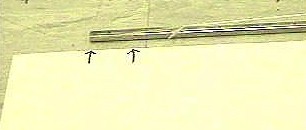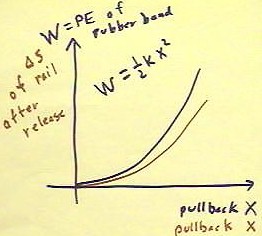"
Class Notes Physics I, 9/21/98
Work and Energy: Rubber Band accelerating Rail
Here we analyze an experiment in which we compare the F * `ds product in stretching
a rubber band to the F * `ds product in sliding a rail accelerated by the rubber band
across the floor. We also observe qualitatively some of the thermal properties of
the rubber band. This provides an example of the work-energy theorem.
Questions:
- We put energy into the rubber-band-and-rail system, in the form of the work we do
stretching the rubber band. In detail, what happens to this energy from the instant
we start pulling back to the instant the rail stops?
- What happens to the KE of the rail as it slides across the floor? Where does
it go?
- From the point of view of the rail, is it doing positive work or negative work as it
slides across the floor?
- Does the rubber band supply more or less energy to the rail than the energy we put
into it, and where does the difference go?
- Does the rubber band exert more or less average force when it accelerates the rail
than when it was pulled back?
- Is a cooler rubber band stiffer or less stiff than a warmer one?
http://youtu.be/V7I-QpKIVGw
http://youtu.be/ZPfQgQkvXZE
The figure below depicts the curved-end ramp in the lab kit.
- Though it is hard to see, a rubber
band tied to a secured string is looped around the left
end of the ramp, or the 'rail' as we will choose to call it for the purposes of
this experiment (since its ramp function is irrelevant, we decided to choose a different
name).
- The string is secured to
the leg of a heavy table, so that when the rail is
pulled back (to the left) the string will remain relatively
fixed rubber band will be stretched.

In the next figure the rubber band has been stretched as
the rail was pulled back.
- The original position of
the end of the rail, and its new position,
are clearly marked by arrows.

When the rubber band was suddenly released, the rail was
thrust forward and ended up in the position
indicated in the figure below, with the arrow marking the end
of the ramp.
Question: If the rail is pulled back twice as far,
stretching the rubber band twice as much, do we expect that the rail
will go twice as far, more than twice as far,
or less than twice as far?
- Think about this question
carefully before reading further.

The rail is now pulled back to a position twice
as far from its resting position as before.
- How far will it go when released?

The rail is seen to go considerably further than before.
- Blue arrows indicate
the first pullback and the distance traveled from the original
position on the first release.
- Red arrows indicate
the second pullback and the distance traveled from the
original position on the second release.
How many times further did
the rail travel when the pullback was doubled?
- Can you explain this
observation? Was it expected?

http://youtu.be/DoexAZfQ-_g
We now turn to the question of how much force is associated with the stretching
rubber band.
- Obviously the force changes, increasing as we stretch
the rubber band further and further.
We measured this force vs. stretch relationship using a lab
scale and a meter stick.
- One end of the
rubber band is attached to a fixed support.
- We actually measured
distances associated with the stretching rubber band in cm;
however on this series of pictures we use inches because
they can be seen more clearly.

We see that when we stretch the rubber band so that the end
attached to the balance moves from the 3.5-inch position to the 4.2-inch
position, the spring in the balance stretches and
therefore the reading on the balance increases.

Stretching the rubber band until it then reaches the 5.3-inch position,
we see that the spring in the balance stretches even further and that the
reading increases further.

If we record our spring reading and end
position data, we can use it to determine how much stretch was
associated with each force.
- The graph we
obtain might well look like that in the figure below.
- A straight line is
depicted which attempts to come as close as possible to the points, on
the average.
- We notice systematic
deviation from linear behavior, with the graph points first
moving further and further above the straight line, then back to
it, then further and further below the line, and finally
back toward the line.
- This indicates that the rubber
band does not give us a precisely linear force vs. stretch
relationship.
http://youtu.be/SOz9JPyxY6c
http://youtu.be/EXcJ1HUI1TA
http://youtu.be/gDgBFPBy-ZI
http://youtu.be/Xyok5JZ3YSs

We now forget about the data points and concentrate
on the straight line that best fits them, keeping in mind
however that the straight line is not a perfect
model for a rubber band.
- In the example below we find that
a 20 cm stretch seems to increase the force by
4 Newtons.
- We therefore calculate the slope
of the graph to be .2 Newtons/cm.
- This means that every cm of
stretch appears to add approximately .2 Newtons to the force.
We also calculate the area under the graph between 0 and 20 cm,
multiplying the average height of the graph by its width.
- The average height is
found by averaging the heights 0 and 4 N;
the width is 20 cm. So the area is 40
N cm.

Recalling that work is defined as the product of average
force and displacement, we see that our area calculation
is identical to the calculation of the work.
- We also note that the slope
of the graph, the number of Newtons of additional force associated
with an additional stretch of 1 cm, is a property of the
rubber band.
- We call this property the force
constant of the rubber band.
(University Physics students:) As you know the area
under a curve can be found by doing an integral.
- In this case, if x represents
the stretch of the rubber band, the force function of
the above graph is clearly F(x) = .2 N / cm * x.
- If we integrate this
function between x = 0 and x = 20 cm, we obtain 40 N cm,
as you easily can, and should, verify.

http://youtu.be/-nWznjWLttE
We can generalize these calculations by noting that if a force F
= kx is exerted to move an object, as was done when we pulled the rail back
against the force of the rubber band, the product of average force and distance
is 1/2 k x^2.
- (Note: the graph below is improperly labeled. Rather than 'Force on
object ...', it should read 'Force to move object'. The force on
the object might be interpreted as be F = - kx, directed opposite to the
displacement x).
- Between positions 0 and x, the force increases from 0
to kx.
- The area under the resulting graph is then area = ave. ht *
width = (0 + kx) / 2 * x = .5 k x^2.
- This area again corresponds precisely to the work done in
moving the object, obtained by multiplying the average force by the displacement.

http://youtu.be/SYTjuXPjf4A
What does all this have to do with how far the rail will
slide across the floor?
- We can arrive at a plausible answer to this question by looking at the force
the rail needs to exert in order to move and
the distance it moves.
- If the rail experienced no friction, it would move along the level
surface at a constant velocity forever.
- However there is a frictional force between the floor and
the rail, resisting the motion.
- If we let f stand for the magnitude of the frictional
resistance, indicated in the figure below by a red arrow directed
opposite to the motion of the rail, we see that the rail
must exert a force F of magnitude equal to f in the opposite
direction to overcome friction.
- The rail therefore does work against friction, with work
= force * distance = | f | * |`ds|.

http://youtu.be/Cw1GyLd5hvc
It should at least be plausible that the amount of work
required to pull the rail back will be equal to
the amount of work done by the rubber band on the rail
when the rail is released (since we expect the rubber band to exert the same
force at the same position in whichever direction the rail
happens to be moving), and that this might be equal to the work the
rail has to do against friction before it stops.
We can therefore interpret the situation somewhat as follows:
- When we pull the rail back, we do work which will be recovered
after we release the rail.
- This work will therefore be present in the rail in the
form of energy of motion.
- Before we release the rail, this work is potentially
there; the potential will become reality after
we release the rail.
- At the instant the rail reaches its original position the
rubber band ceases to accelerate it, and it has its maximum
energy of motion.
- As the rail slides across the floor, this energy is dissipated
in the form of work done against friction.
- This continues until all the energy is dissipated
and the rail stops.
The energy that was potentially present in the rubber band,
which was equal to the work we did when we pulled the
rubber band back, is called potential energy,
abbreviated PE.
- From our graph of F vs. x, and our knowledge that the area
under the graph from 0 to x is the approximate work .5 k
x^2 done in stretching rubber band, we see that the potential
energy of the rubber band is .5 k x^2.
- This function is graphed in blue in the figure below.
In the same figure we make the red graph of the displacement
of the rail after its release from the rubber band vs. the pullback.
- The data for this graph were
obtained by observation.
- The graph is seen to have
essentially the same shape as the potential energy graph:
theoretically if we choose our vertical scale just right
the graphs would coincide.

This is exactly what we would expect if the frictional force f is constant.
- If that is the case then, if f
`ds = .5 k x^2 (that is, if the work done against
friction as the rail slides is equal to the work
done on it by the rubber band as it accelerates the
rail), then we have `ds = .5 k x^2 / f = (.5 k / f) * x^2.
- This graph is just a vertical
stretch by factor 1/f of the graph of .5
k x^2. This relationship expresses the proportionality of `ds
with .5 k x^2.
The figure below shows the graph and states the interpretation
that the rail obtains energy equal to.5 k x ^ 2 from
the rubber band, and that this energy is then dissipated
as f `ds.
- This is an application of the work-energy
theorem, which states that the energy of a closed system is conserved.
- We will see a more complete
statement of this theorem soon.

http://youtu.be/7mDjiIPQbbA
"
